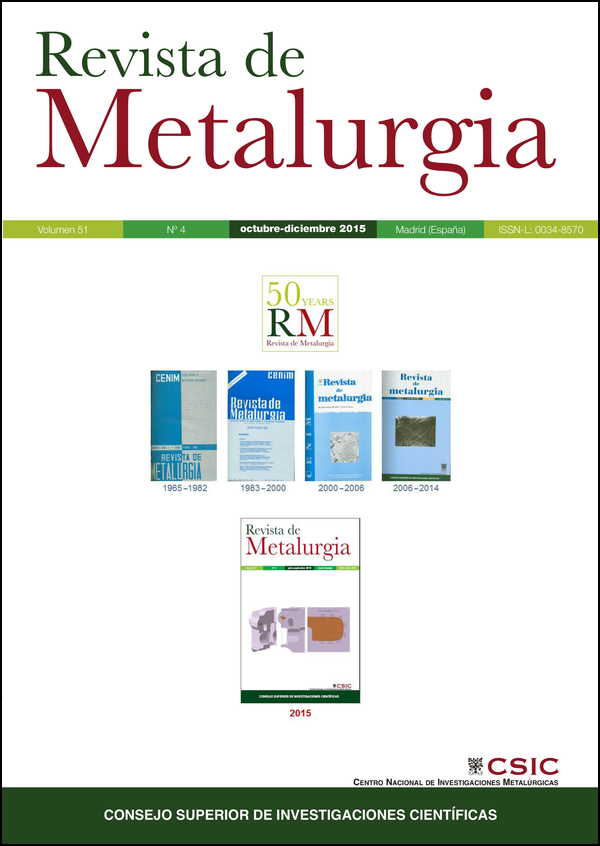Estudio experimental de procesos de soldadura con alto contenido en hidrógeno
DOI:
https://doi.org/10.3989/revmetalm.055Palabras clave:
Hidrógeno difusible, Método de la glicerina, Método del mercurio, Soldadura subacuática, SoldabilidadResumen
Este trabajo presenta los resultados de una investigación sobre la determinación del contenido de hidrógeno difusible en el material aportado mediante dos métodos: el de la glicerina (el más utilizado) y el del mercurio. El contenido de dicho hidrógeno se ha definido a partir de los resultados de esos métodos en una zona con bajo contenido en hidrógeno, así como procesos de soldadura con alto contenido en hidrógeno. No hay datos disponibles en la literatura para contenidos de hidrógeno difusible en metal depositado mayores de 35 ml/100 g. Ampliando el análisis de la cantidad de dicho hidrógeno hasta los 80 ml/100 g, se simplifica considerablemente la realización de ensayos de soldabilidad del acero en procesos de alto contenido en hidrógeno así como en la soldadura en medio acuoso.
Descargas
Citas
Anon. (1974). Relation between hydrogen contents by IIW and JIS method. International Institute of Welding, Document IIW Doc. II-698-74.
Anon. (1986). Method of measurement for hydrogen evolved from steel welds. International Institute of Welding, Document IIW Doc. II-1073-86.
Coe, F.R. (1972). The comparison of hydrogen levels. International Institute of Welding Document IIW Doc. II-A-305-1972.
Fydrych, D., ¸abanowski, J. (2012). Determining diffusible hydrogen amounts using the mercury method. Weld. Int. 26 (9), 697–702. http://dx.doi.org/10.1080/09507116.2011.592682
Fydrych, D., ¸abanowski, J., Rogalski, G. (2013). Weldability of high strength steels in wet welding conditions. Pol. Marit. Res. 20 (2), 67–73. http://dx.doi.org/10.2478/pomr-2013-0018
Grela, P., Mazur, M. (2002). Comparison investigations of hydrogen diffusing from weld deposit determined by glycerin and mercury methods. Institute of Welding Bulletin 46, 54–55.
ISO 3690 (2012). Welding and allied processes. Determination of hydrogen content in arc weld metal.
Kannengiesser, T., Tiersch, N. (2010). Comparative study between hot extraction methods and mercury method—A national round robin test. Weld. World 54 (5), R108-R114. http://dx.doi.org/10.1007/BF03263496
Karkhin, V.A., Levchenko, A.M. (2008). Computer-aided determination of diffusible hydrogen in deposited weld metal. Weld. World 52 (2), 3–11. http://dx.doi.org/10.1007/BF03266624
Kotecki, D.J. (1992). Hydrogen reconsidered. Weld. J. 71 (8), 35–43.
Kotecki, D.J. (1994). Aging of welds for hydrogen removal. Weld. J. 73 (6), 75–79.
Kozak, T. (2011). Resistance to cold cracking of welded joints made of P460NL1 steel. Adv. Mater. Sci. 11 (3), 20–27. http://dx.doi.org/10.2478/v10077-011-0014-8
Kühn, S., Unterumsberger, F., Suter, T., Poh, M. (2013). New methods for analysis of diffusible hydrogen in high-strength steels. Materials Testing 55 (9), 648–652. http://dx.doi.org/10.3139/120.110483
Kurji, R., Coniglio, N. (2015). Towards the establishment of weldability test standards for hydrogen-assisted cold cracking. Int. J. Adv. Manuf. Tech. 77 (9), 1581–1597. http://dx.doi.org/10.1007/s00170-014-6555-3
López, F.A., Sierra, M.J., Rodríguez, O., Millán, R., Alguacil, F.J. (2014). Non-isothermal kinetics of the thermal desorption of mercury from a contaminated soil. Rev. Metal. 50 (1), e001. http://dx.doi.org/10.3989/revmetalm.001
López, F.A., Alguacil, F.J., Rodríguez, O., Sierra, M.J., Millán, R. (2015). Mercury leaching from hazardous industrial wastes stabilized by sulfur polymer encapsulation. Waste Manage. 35, 301–306. http://dx.doi.org/10.1016/j.wasman.2014.10.009
Padhy, G.K., Ramasubbu, V., Albert, S.K., Murugesan, N., Ramesh, C. (2012). Hot extraction of diffusible hydrogen and its measurement using a hydrogen sensor. Weld. World 56 (7), 18–25. http://dx.doi.org/10.1007/BF03321361
Padhy, G.K., Komizo, Y. (2013). Diffusible hydrogen in steel weldments -a status review. Transactions of JWRI 42, 39–62.
Padhy, G.K., Ramasubbu, V., Parvathavarthini, N., Wu, C.S., Albert, S.K. (2015a). Influence of temperature and alloying on the apparent diffusivity of hydrogen in high strength steel. Int. J. Hydrogen Energ. 40 (20), 6714–6725. http://dx.doi.org/10.1016/j.ijhydene.2015.03.153
Padhy, G.K., Ramasubbu, V., Albert, S.K. (2015b). Rapid determination of diffusible hydrogen in steel welds using a modified gas chromatography facility. J. Test. Eval. 43 (1), 69–79. http://dx.doi.org/10.1520/JTE20130077
Pan’cikiewicz, K., Zielin’ska-Lipiec, A., Tasak, E. (2013). Cracking of high-strength steel welded joints. Adv. Mater. Sci. 13 (3), 76–85.
Pokhodnya, I.K., Yavdishchin, I.R., Paltsevich, A.P., Shvachko, V.I., Kotelchuk, A.S. (2004). Metallurgy of arc welding. Interaction metal with gases. Naukova Dumka, Kiev.
Quintana, M.A. (1984). A critical-evaluation of the glycerin test. Weld. J. 63 (5), 141–149.
Stanisz, A. (2007). The accessible course of statistics with applying STATISTICA PL using the examples from medical science. Linear and non-linear models. Vol. II., StatSoft, Poland.
Ström, C., Elvander, J. (2004). Calibration and verification of the hot extraction method including a comparison with the mercury method. International Institute of Welding Document IIW Doc. II-1543-04.
Swierczyn’ska, A., Fydrych, D., ¸abanowski, J. (2012). The effect of welding conditions on diffusible hydrogen content in deposited metal. Solid State Phenom. 183, 193–200 http://dx.doi.org/10.4028/www.scientific.net/SSP.183.193
Publicado
Cómo citar
Número
Sección
Licencia
Derechos de autor 2015 Consejo Superior de Investigaciones Científicas (CSIC)

Esta obra está bajo una licencia internacional Creative Commons Atribución 4.0.
© CSIC. Los originales publicados en las ediciones impresa y electrónica de esta Revista son propiedad del Consejo Superior de Investigaciones Científicas, siendo necesario citar la procedencia en cualquier reproducción parcial o total.
Salvo indicación contraria, todos los contenidos de la edición electrónica se distribuyen bajo una licencia de uso y distribución “Creative Commons Reconocimiento 4.0 Internacional ” (CC BY 4.0). Consulte la versión informativa y el texto legal de la licencia. Esta circunstancia ha de hacerse constar expresamente de esta forma cuando sea necesario.
No se autoriza el depósito en repositorios, páginas web personales o similares de cualquier otra versión distinta a la publicada por el editor.
















